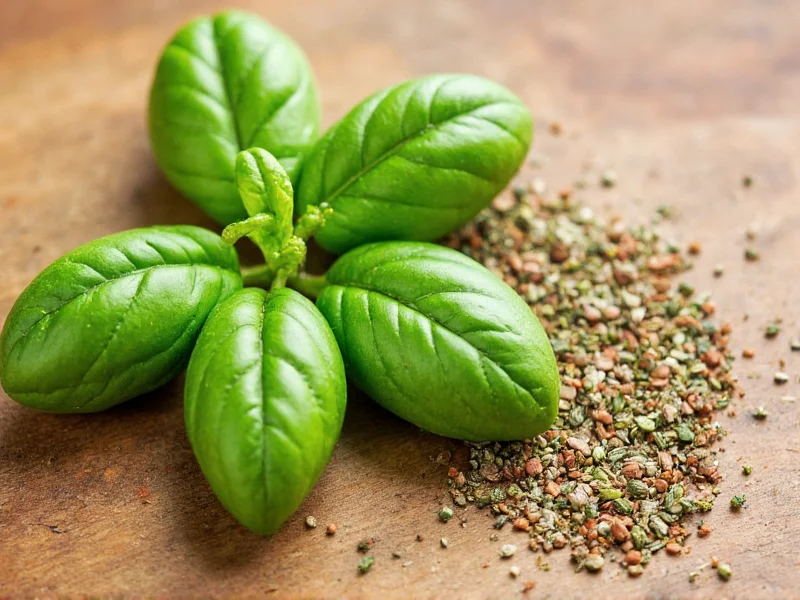Understanding Basil Seasoning Varieties
Basil seasoning appears in multiple forms, each suited to different culinary applications. Fresh basil leaves deliver vibrant, aromatic notes that diminish with heat, making them ideal for garnishes and cold preparations. Dried basil undergoes oxidation that concentrates its eugenol compounds, creating a more intense, earthy profile that withstands prolonged cooking.
Chef-developed blends often combine dried basil with complementary herbs like oregano, thyme, and garlic powder. These Italian herb seasoning mixes create balanced flavor foundations for tomato-based sauces and roasted vegetables. When selecting commercial blends, check ingredient lists for fillers like maltodextrin that dilute authentic herb potency.
Flavor Chemistry and Culinary Applications
Basil's distinctive taste comes from linalool (floral notes), eugenol (spicy warmth), and methyl cinnamate (sweet aroma). These compounds interact differently based on preparation:
| Preparation Method | Flavor Impact | Best Uses |
|---|---|---|
| Fresh, raw | Bright, sweet with peppery finish | Pesto, caprese salads, finishing pizzas |
| Dried, added early | Earthy, concentrated herbal notes | Tomato sauces, soups, braises |
| Dried, added late | Milder, more nuanced flavor | Marinades, dressings, compound butters |
| Infused oils | Subtle aromatic essence | Drizzling over finished dishes |
Optimal Pairings for Basil Seasoning
Certain ingredients amplify basil's natural chemistry. Tomatoes share glutamic acid compounds that create synergistic umami when combined with basil's volatile oils. Garlic's allicin reacts with basil's linalool to produce more complex aromatic compounds during cooking. Understanding these natural flavor pairings for basil seasoning elevates dish development.
For Italian cooking with basil seasoning, combine with:
- San Marzano tomatoes (higher lycopene content)
- Fresh mozzarella (fat carries basil's essential oils)
- Extra virgin olive oil (preserves volatile compounds)
- Balsamic vinegar (acidity balances sweetness)
Storage Techniques for Maximum Freshness
Proper storage maintains basil seasoning's volatile compounds. Store dried basil in airtight containers away from light and heat. Glass jars with oxygen absorbers preserve potency up to 12 months. Fresh basil requires different handling:
- Refrigerate stems in water like flowers (change water every 2 days)
- Never seal fresh basil in plastic (traps ethylene gas)
- Freeze whole leaves in olive oil for cooking applications
- Dry fresh basil using a food dehydrator at 95°F (35°C) for 8-12 hours
Common Usage Mistakes to Avoid
Many home cooks make critical errors when using dried basil seasoning in recipes. Adding dried herbs too late in cooking prevents proper rehydration and flavor release. Conversely, adding fresh basil too early causes volatile oils to evaporate. The optimal timing differs:
- Dried basil: Add during the last 15-20 minutes of cooking
- Fresh basil: Stir in during the final 2-3 minutes or use raw
- Never cook fresh basil in oil above 250°F (121°C)
- Toast dried basil briefly in dry pan to intensify flavor
Substitution Guidance and Equivalencies
When substituting basil seasoning alternatives, consider flavor profiles. Tarragon shares similar anise notes but lacks sweetness. Oregano provides earthiness but with more pungency. For accurate substitutions:
- 1 tsp dried basil = 1 tbsp fresh basil
- Replace 75% of basil with oregano for robust dishes
- Add pinch of sugar to compensate for lost sweetness
- Use lemon thyme for brighter alternatives
Creating Custom Basil Blends
Develop personalized homemade basil seasoning recipes by combining dried basil with complementary ingredients. A classic Italian blend uses:
- 3 parts dried basil
- 2 parts dried oregano
- 1 part dried thyme
- ½ part garlic powder
- ¼ part red pepper flakes
Toast whole herbs before grinding to activate essential oils. Store blends in dark glass containers for optimal shelf life. For tomato basil seasoning combinations, add 1 tsp dried basil per cup of tomato product during the last 10 minutes of cooking.











 浙公网安备
33010002000092号
浙公网安备
33010002000092号 浙B2-20120091-4
浙B2-20120091-4